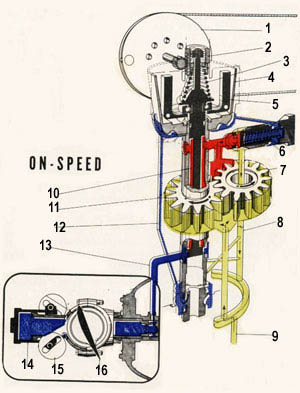| AIRCRAFT PROPELLER CONTROL AND OPERATION |
|
| |
Control and Operation (page 2) |
| |
Governor Operation Condition |
| |
On-Speed Condition
The on-speed condition exists when the propeller operation speed are constant . In this condition, the force of the flyweight (5) at the governor just balances the speeder spring (3) force on the pilot valve (10) and shutoff completely the line (13) connecting to the propeller , thus preventing the flow of oil to or from the propeller. |
| |
  |
| |
The pressure oil from the pump is relieved through the relief valve (6). Because the propeller counterweight (15) force toward high pitch is balanced by the oil force from cylinder (14) is prevented from moving, and the propeller does not chang pitch |
Under-Speed Condition
The under-speed condition is the result of change in engine r.p.m. or propeller r.p.m.which the r.p.m. is tend to lower than setting or governor control movement toward a high r.p.m. Since the force of the flyweight (5) is less than the speeder spring (3) force , the pilot valve (10) is forced down. Oil from the booster pump flows through the line (13) to the propeller. This forces the cylinder (14) move outward , and the blades (16) turn to lower pitch, less power is required to turn the propeller which inturn increase the engine r.p.m. As the speed is increased, the flyweight force is increased also and becomes equal to the speeder spring force. The pilot valve is move up, and the governor resumes its on-speed condition which keep the engine r.p.m. constant. |
| |
 |
| |
Over-Speed Condition
The over-speed condition which occurs when the aircraft altitude change or engine power is increased or engine r.p.m. is tend to increase and the governor control is moved towards a lower r.p.m. In this condition, the force of the flyweight (5) overcomes the speeder spring (3) force and raise the pilot valve (10) open the propeller line (13) to drain the oil from the cylinder (14). The counterweight (15) force in the propeller to turn the blades towards a higher pitch. With a higher pitch, more power is required to turn the propeller which inturn slow down the engine r.p.m. As the speed is reduced, the flyweight force is reduced also and becomes equal to the speeder spring force. The pilot valve is lowered, and the governor resumes its on-speed condition which keep the engine r.p.m. constant. |
| |
 |
| |
Flight Operation
This is just only guide line for understanding . The engine or aircraft manufacturers' operating manual should be consulted for each particular aircrat. |
| |
Takeoff : Placing the governor control in the full forward position . This position is setting the propeller blades to low pitch angle Engine r.p.m. will increase until it reaches the takeoff r.p.m. for which the governor has been set. From this setting , the r.p.m. will be held constant by the governor, which means that full power is available during takeoff and climb.
Cruising : Once the crusing r.p.m. has been set , it will be held constant by the governor. All changes in attitude of the aircraft, altitude, and the engine power can be made without affecting the r.p.m. as long as the blades do not contact the pitch limit stop.
Power Descent : As the airspeed increase during descent, the governor will move the propeller blades to a higher pitch inorder to hold the r.p.m. at the desired value.
Approach and Landing : Set the governor to its maximum cruising r.p.m. position during approach. During landing, the governor control should be set in the high r.p.m. position and this move the blades to full low pitch angle. |
| |
|
|
|
|
|
|
|
| |